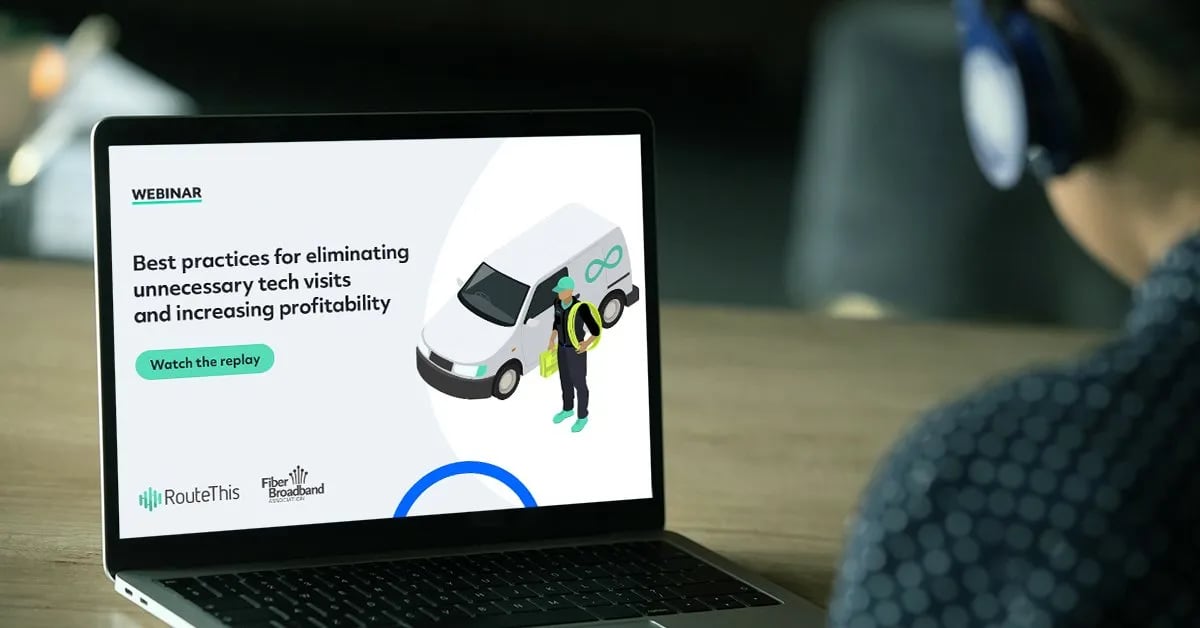Event recap: The 3 types of tech visits and how to reduce them

Last week, we got together with the Fiber Broadband Association for an online event covering one of an ISP’s biggest pain points: technician visits.
The session, which featured RouteThis CEO Jason Moore and Director of Product Mike Giannotta, showcased the various types of tech visits that ISPs need to watch out for and the best practices these ISPs can implement to keep tech visits to a minimum.
In case you weren’t able to attend, here’s a quick recap of the session—and you can watch the full recording here.
In this post
- 3 types of technician visits
- 5 best practices to keep tech visits under control
The 3 types of technician visits
The first step to solving any problem is understanding it—so of course, the first thing Moore brought to light is the hidden causes behind unnecessary tech visits. As he explained, there are three main types of these visits:
The ones that add no value to your business or your subscribers
These tech visits are typically what you’d consider your no fault found (NFF) visits, where the tech gets to the subscriber’s home, goes through their process, tries to resolve the issue, and determines that there was no issue to start with.
[NFF visits] account for about 20% of service provider truck rolls.
Jason Moore, CEO, RouteThis
The ones that could have been avoided
These are the tech visits where the subscriber is convinced they’re having an issue that requires a tech—but if support agents had the right ISP support tools at their disposal, they could have resolved it without ever having to send the technician at all.
As Moore explained, a study commissioned by RouteThis this year found that up to 17% of WiFi-related support calls end in tech visits—but with proper network visibility tools, agents could resolve those issues remotely. And as an early audience poll showed, 75% of ISPs said that WiFi issues were the top reason for unnecessary technician visits.
The ones that happen more than once
Too often, technicians get called back out to a subscriber’s home for a repeat issue. These calls happen because either the technician didn’t have the right information or tools, or because they reported NFF but the subscriber continued to experience problems.
This category accounts for about 25% of unnecessary technician visits.
What can ISPs do to keep tech visits under control?
As part of the session, Moore highlighted several best practices that the team at RouteThis has seen various ISPs around the world use to help minimize the impact that unnecessary technician visits have on their overall business.
1. Use a tech visit approval process.
This sort of process is designed to keep the techs from rolling out at random; sometimes, it gates the ability to send a tech behind a checklist the agent has to complete. Other times, it features a senior team member who reviews any and all requests before they go through to the tech team.
2. Get your agents insight into home networks.
If agents can see what’s going on with a home network, issue resolution won’t turn into a guessing game that ends in a tech visit. Moore’s advice? Look for solutions that can work around CPE, roll out quickly, don’t cost a lot per sub, and can guide agents through resolutions to help newer team members ramp up.
3. Give your subscribers options to resolve on their own.
Subscribers will often try to resolve WiFi issues before they call support, so by providing options to help them do that, Moore explained, it’s possible both to reduce unnecessary tech visits and reduce the load on your support team. These solutions need to be exceptionally easy to use, accessible, and capable of providing tips for specific issues.
One of the biggest reasons that self-service tools like knowledge bases or FAQs often fail for WiFi issues is that they’re not contextualized; most of them read as long, back-to-back guides of ‘try this, if that doesn’t work try this, and if that doesn’t work, try this.’
The average consumer doesn’t have the patience to run through a checklist of 10 things before they call into support.
Jason Moore, CEO, RouteThis
4. Think about ways you can do visual support.
When agents can physically see a subscriber’s home network setup through videos and photos, it’s much easier for them to identify issues that might otherwise have necessitated a tech visit—like cabling issues, placement, and more.
5. Make sure you nail the WiFi installation.
Turnaround tech visits from WiFi installations account for almost 5% of unnecessary visits. The key to improving this number? Make sure your WiFi installations use a process that can test and optimize WiFi diagnostics and the WiFi experience throughout the home, not just the subscriber’s internet connection at the router. That’s what they’ll use the most, after all.
